In this article, we will delve into the beta version of Voyager Linux 23.10. We’ll explore the user experience, system performance, and some noteworthy features of this distribution. Keep in mind that this is a beta release, so there may be some issues.

Booting into Live Mode
Upon booting up the beta version of Voyager Linux 23.10, the user is greeted with the boot menu. The first step is to choose the language.
Live Boot vs. Installation
Before proceeding, it’s advisable to initiate a live boot by selecting the “Try Voyager” option. This allows you to evaluate the distribution’s performance and stability. If everything goes smoothly during the live boot without encountering any bugs, you can consider proceeding with the installation.
Installation Process
The installation process is accessible from the desktop. However, it’s recommended to thoroughly test the live boot before making a decision.
Upgrading vs. Fresh Installation
For normal users, upgrading to this beta version is not recommended. It’s better to wait for the stable ISO file to be released before considering an upgrade.
Changing Display Settings
After booting into the live environment, consider adjusting display settings as per your preferences. Check your monitor’s resolution settings to ensure optimal display.
System Information
Here are some details about the system being used for testing:
- Operating System: Voyager 23.10 Beta
- Virtualization: VMware
- CPU: 12th Gen Intel Core i5
- Memory: 4GB RAM
- Hard Disk: 40GB
System Monitor
Monitoring system resource usage is crucial. During the live boot, it’s observed that approximately 2GB of RAM is being utilized. Keep an eye on both RAM and CPU usage to assess system performance.
Performance Observations
During testing, some performance issues were noted. The distribution exhibited lag and sluggishness, particularly when running with 4GB of RAM. Animations and responsiveness were affected.
Command Line Testing
Various command-line tests were conducted to gather system information, including kernel version, running processes, and hardware details.
Installed Applications
Voyager Linux 23.10 Beta comes with a variety of pre-installed applications, providing a range of functionalities.
Resource Consumption
When multiple applications were opened concurrently, RAM usage increased to around 3GB. It’s worth noting that this level of resource consumption may not be suitable for systems with limited RAM.
Application Compatibility
While opening multiple applications, some compatibility issues were observed, causing delays and unresponsiveness in certain cases.
Browser Version
The distribution includes Firefox version 118, which is ahead of the standard Ubuntu release.
Extension Manager
Voyager Linux offers a customizable extension manager to enhance the user experience.
Closing Remarks
In conclusion, the beta version of Voyager Linux 23.10 exhibits some performance issues, particularly in resource-intensive scenarios. It is advisable to wait for the stable ISO file if you intend to use this distribution for regular tasks. If you decide to test it, share your experiences in the comments, as it can help others assess its suitability.
End of Article
Thank you for reading this detailed review of Voyager Linux 23.10 Beta. We hope this information helps you make an informed decision about using this distribution.